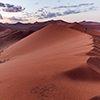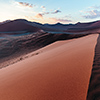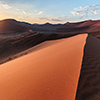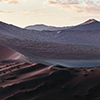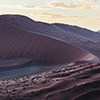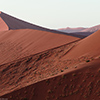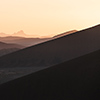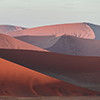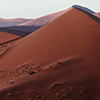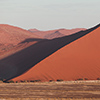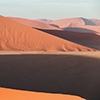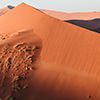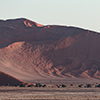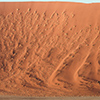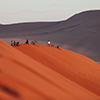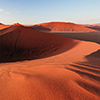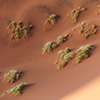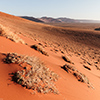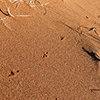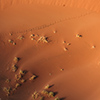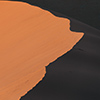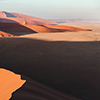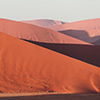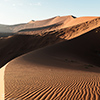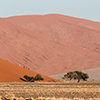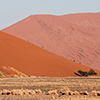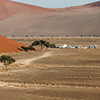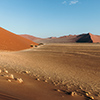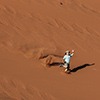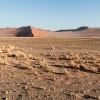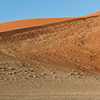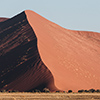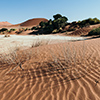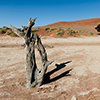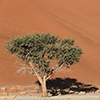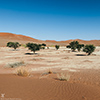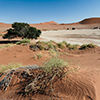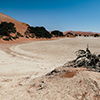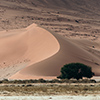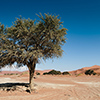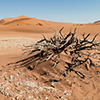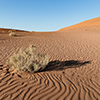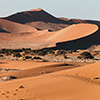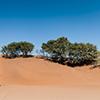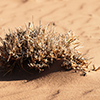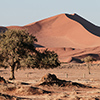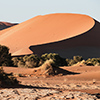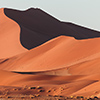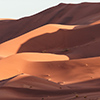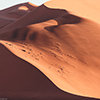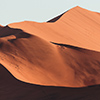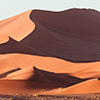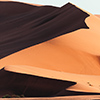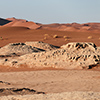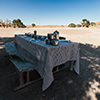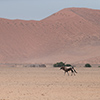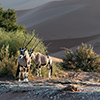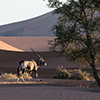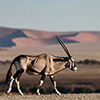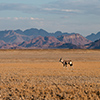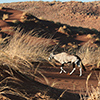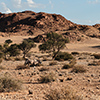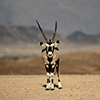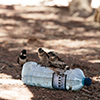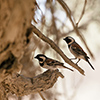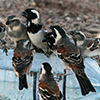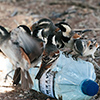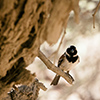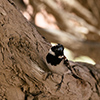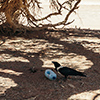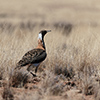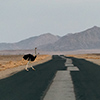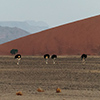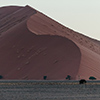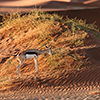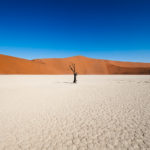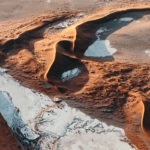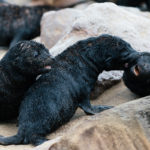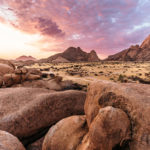Dune 45 – Sunrise above Namib desert
The giant red dunes of Namib desert belong to the worldwide tallest of its kind. They pile up at Sossusvlei, were Tsauchab River disappears in the sand of Namibia. Only one of those sand heaps may be climbed, that is the dune at kilometre 45. It rises up some ~170 metres high and is built by 5-million-year old sand deposits of the Kalahari. From its top one my witness the play of colours a sunrise in the desert can paint.
Get up early is half the battle
There was no petrol station and no shop selling cold drinks when I visited Sesriem, the entrance to Namib dunes, for the first time back in 2003. Today that’s pretty different and you can even start with lobster for breakfast into the new day when staying at private-run Sossusvlei Lodge. One thing hasn’t changed though, that is state-run Sesriem Campsite having the privilege to open the national park gates to the dunes in the morning at first. And that’s why I am staying here again.
With my jeep I gather at the gate about 20 minutes before it gets opened. I am by far not the only one embarking on a trip into the desert, but since I am a well prepared lone fighter I am the fastest and first one to start the drive into the desert. Also I am forerunner climbing dune 45… Oh yes, that bloody dune ascent…, another unforgotten thing dating back to 2003. At that time I didn’t even drag camera equipment to the top, but struggled with sand and sandals.
When feet sink into the dune then one quickly notices that the cold sand layer is quite thin and that the sand is pretty much warm, still. Climbing dunes while having eaten no breakfast isn’t fun. Yet dozing I slip down half a step each step having made up. Back in 2003 the sandals didn’t let me walk up properly and now it’s the 20kg photographic extra baggage on my back. Up on the top it makes sense to walk even further as it doesn’t take much time until more people will arrive; muuuch more people.
Quickly I found a good spot and settle down to put up my tripod as the start of the sunrise already looms at the horizon as gentle purple nuances. I perceive the sand formations at my feet first only as outlines, but the more light gets involved the curved lines become sandy pattern reaching up to the horizon. Watched from up here they look so tiny and not like giants. More and more other travellers have reached the dune’s bottom now trying to walk up the ridge and like ants on a string of pearls.
Play of Sunlight Colours
Although, or better to say because the sun is visible only indirectly, the camera has to manage the balancing act of capturing the very shadows as well as highlights. For the human eye that means bring bright sky and dark sand formations together. At that time blue, violet and ruby are the dominant colours, but when the sun appears then the giant dunes start to shine in finest flawless rust-ret with touches of orange and yellow. Fortunately that rendezvous of sand gets interrupted by small tufts of grass only and not human traces. It’s a treat for the eyes to follow the long cutting dune ridges and watch the shadows they cast.
The sunrise itself lasts about half an hour. The central star has barely made it above the horizon line but one can already get a glimpse of what the immense heat in the desert might feel like later. Meanwhile I am not alone anymore and people crowd even back here, where I thought to sit on my own. People push past and – dumb as well as absent-minded as they usually are – walk through my picture. Well, what else than landscape photography should I do up there when sitting with a tripod and big camera equipment on a dune…?
I quickly caught up on the missed image. More annoying is to align the tripod again after each tourist having pushed past as sand moves and sand is our ground. Why I am upset? Because I wouldn’t have the merest idea of destroying other people’s photos.
Too many people in one place mean concentration. Concentration causes friction. And that’s how in the middle of the desert one suddenly has to struggle with globalisation as booming travel industry brings more and more people to special places. That was foreseeable even back in 2003… I don’t expect to have such location generally for my own but I expect some manners, friendliness as well as switched on brains to make places like dune 45 being maximum enjoyable for everyone but that’s a wish and dune 45 isn’t far at all from sunrise experiences at the Tengger caldera.
Meanwhile the play of colours has faded away and the light of the glaring sun becomes harder. I wrap my photo equipment airtight as desert sand is incredibly fine. It invades anything and I still want to have some fun running down the dune’s slope. It’s half-running, half-wobbling and falling down is super soft. By the way, the wind flattens those human traces again, every night anew.
Life in the Desert
My ride goes on. Yet my jeep rolls over asphalt but soon I have to release some tyre pressure as the last kilometres to reach Sossusvlei are nothing but pure loose desert sand and the numerous other jeeps as well as overland trucks pretty much churned up the place already. At the Vlei already shade offering trees are waiting. Those acacias are home to weaver birds. How many of them live and survive in hostile desert heat can be witnessed, when providing them a little cup of water. Then they instantly rush down from the trees to enjoy the wet.
For the prosperous society an opulent breakfast got dished up at Sossusvlei, with set tables and champagne. At noon that fuss is over, because it’s boiling hot now and most people can’t cope with that. I wait in the shadow of the acacia trees and make friendship with the local weaver birds as suddenly a tourist couple turns up having tried to climb the Big Mama dune in the blaze of the noon desert sun. They had to give up as their sandals melted and their feet already showed first blisters from burns.
That’s why in deserts I wrap up myself with long clothing, for example on the way down to Deadvlei. In long pants one sweats like a horse but heat and sand have no contact possibility. Most of the visitors roam around Sossusvlei until noon and disappear again. Then one can have and enjoy the desert on one’s own and animals appear. Only God knows where Oryx, ostrich & co. hide away from the blazing heat during the day… The desert animals are significantly wirier than their elsewhere living conspecifics. Stoically and a little leery they look at me but don’t let disturb themselves.
I have to hurry up as soon the gate of the national park closes and too late arrivals get fined. In the last light of the day I may witness how a group of male ostrich roam through the desert on the hunt for food. I decide to stay a second day at Sossusvlei and to hire a helicopter in the morning. Also on the second day I get rewarded with wildlife impressions, in the evening again, when young Oryx walked around on the search for food. Apparently those animals adapted themselves perfectly to hostile life conditions as they can even reproduce themselves.

